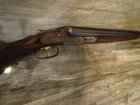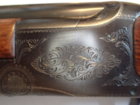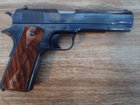You are using an out of date browser. It may not display this or other websites correctly.
You should upgrade or use an alternative browser.
You should upgrade or use an alternative browser.
Blueing ?
- Thread starter Shrek
- Start date
shortgrass
Silver $$ Contributor
Bluing is all about the metal prep. Polishing is almost a lost art. No rounded corners, no dished screw holes, no ripples. Cleanliness before going into the tank. No grease, no oil, no finger prints. Following the manufacturers directions for the mix and temp of the bluing tank. Du-Lite makes and markets the best bluing salts in my opinion. Those high gloss factory blue jobs were probably only polished to 320 or 400 grit. The higher the grit finish, the glossier the finish. While in gunsmith school I polished to 1200g when bluing for a grade. It's not as easy as many seem to think it is... To 'work' properly, the "hot tank" needs to be fired (brought to operating temp) regularly. You can fool a lot of the people most of the time, but ya' can't fool those who know what they're looking at.
What is the process and how difficult is it to do quality blueing like you might get on an old Belgium Browning ? I rarely see the deep luster of the older guns and really know little to nothing about the process.
The bluing you are talking about is not typical hot tank bluing such as "Oxynate #7", it is actually rust bluing, "fume" bluing or so-called Belgian blue. Which are all similar processes.
Maybe we are not talking about the same thing...modern hot blue is very deep and almost black. What you describe, "on an old Belgian Browning" has more of a bluish look and also has a kind of silvery glow to it.
Metal prep is one thing and while it definitely contributes to the finished product, actually coloring the metal is another. As far as the coloring goes a good quality Belgian blue can be done with little more than a tank to boil water and the parts in, a very fine wire brush and the chemical. It is swabbed on and left to "rust", then the parts are boiled and the "rust" turns black. The part is dried and carded off with a fine wire brush. "Prep" as well as the type of steel determines how many times you have to repeat this to get the desired color.
This is a pretty simplified "in a nutshell" description and there is more to it, but in general this is it. Fume bluing is done in a big cabinet and the chemical goes on as a vapor. End result is the same, it's just a faster way to do a lot more parts.

This is a Lefever EE grade from 1905, notice the blue glow of the barrels.

This one is a Browning Superposed 20 gauge from about 1937. Same bluish glow...

This gun, a Winchester Model 12 Super Pigeon dates to 1961, notice the blacker, darker color of the hot bluing in use at the time.
Last edited:
shortgrass
Silver $$ Contributor
I'd say , "old Belgium Browning" needs to be more clearly defined. He could be talking about a A5, not a Superposed. "Old",,,,,, how old?
Yes sir, the A-5 has been around longer than the Superposed and was blued the same way until they left Belgium and went to Japan. They were hot blued at Miroko. I understand what you are saying and I agree, that is why I posted pictures of both..."deep luster" and "on an old Belgian Browning" are two different finishes to me too.
Then again there's what Colt called "royal blue", such as this 1911 civilian from 1920. It was offered as an option and is a very high polish. Not too sure though how they did the actual bluing. This one has never been fired. The grips are obviously not original. Those were ruined by the way it was stored packed in heavy grease.

Then again there's what Colt called "royal blue", such as this 1911 civilian from 1920. It was offered as an option and is a very high polish. Not too sure though how they did the actual bluing. This one has never been fired. The grips are obviously not original. Those were ruined by the way it was stored packed in heavy grease.

Last edited:
Dusty Stevens
Shiner
I have a colt 1911 from the 80’s at the latest that has a blue on it that looks almost like it has a clearcoat. Real deep finish like the old royal blue but lots deeper. I like that finish more than the blacker ones
Liven The Dream
Gold $$ Contributor
Rust Blueing Old School.
Had a 1950’s Gun Smith Book .
Covered this very well . There was I Guy named Nieder ? Covered a Tank iron nails and electrodes??
Had a 1950’s Gun Smith Book .
Covered this very well . There was I Guy named Nieder ? Covered a Tank iron nails and electrodes??
Last edited:
I think it’s the vapor rust blueing I’m thinking of. The really black hot tank blueing like on the Winchester above isn’t what I was thinking of. I had a ‘58 Belgium Light 20 that I thought was beautiful. Had the orangeish patina to the old wood. Unfortunately I couldn’t shoot it to save my life and was made an offer I couldn’t refuse for it at a dove shoot. I was thinking of that A5 when I made the post.
RUST BLUING!!!!!!!
not dust gluing!
Auto correct can kiss my @#$%!!!!!
Haha, don’t you just love it?
lots of info on cold bluing, rust bluing.. how to make formulas for bluing, how to build rust bluing boxes.Rust Blueing Old School.
Had a 1950’s Gun Smith Book .
Covered this very well . There was I Guy named Nieder ? Covered a Tank iron nails and electrodes??
https://www.amazon.com/dp/B000I1IUYY/?tag=accuratescom-20
Similar threads
- Replies
- 14
- Views
- 662
- Replies
- 18
- Views
- 6,709
Upgrades & Donations
This Forum's expenses are primarily paid by member contributions. You can upgrade your Forum membership in seconds. Gold and Silver members get unlimited FREE classifieds for one year. Gold members can upload custom avatars.

Click Upgrade Membership Button ABOVE to get Gold or Silver Status.
You can also donate any amount, large or small, with the button below. Include your Forum Name in the PayPal Notes field.
To DONATE by CHECK, or make a recurring donation, CLICK HERE to learn how.

Click Upgrade Membership Button ABOVE to get Gold or Silver Status.
You can also donate any amount, large or small, with the button below. Include your Forum Name in the PayPal Notes field.
To DONATE by CHECK, or make a recurring donation, CLICK HERE to learn how.









